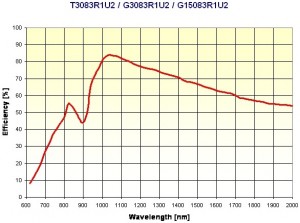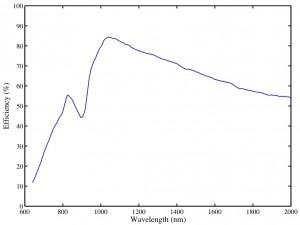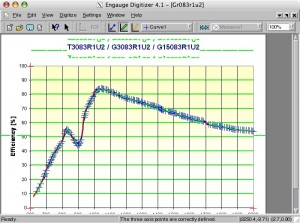In the time I’ve been doing my research work at the Univ. of IL, I’ve come across a number of graphs from various past researchers, older papers, stuck on the side of machines (calibration curves), and even hand-drawn or chart-recorder graphs in my numerous projects. The only major problem with those graphs I’ve found is that they aren’t in a digital form for further use with other data (instrument response functions) or to include in your own work as a reference. So, what to do?
Well, there’s an easy solution. It’s not the perfect solution, as it’s a bit slow, I’ll get to that in a second, but it’s a great solution to the problem, and has worked for me a number of times now. To top it off, it’s open-source, donation-ware, and cross-platform: Engauge Digitizer (see post at LifeHacker.com). Don’t let the website and lack of recent updates deter you. Tools that can do what Engauge does are few and far between. So, it is definitely worth a try. Here’s an example of how I’ve used it just the other day (prompting this post- I’ve used it for years now, but the recent use reminded me I should share it with others). [click "More" to see an example use and learn more]
So, pretend you’re doing Cryogenic Cathodoluminescence measurements with a Gatan MonoCL system, and you want to know what the efficiency curves are, and in fact, you may want to use them to alter your data to correct for the grating response. Only problem? You can’t find the actual data for the grating response with wavelength anywhere… except for this one gif…

Great, so that’s the grating response (this is a Bentham 83, 1.2 micron blaze). With a bit of work in Engauge Digitizer, and some simple plotting in MATLAB, you can turn that picture into this…

You say big woop- well, true, it’s not that big a deal until you need to use that curve to alter some of your data to correct for the 20% efficiency difference between say 1100 nm and 1600 nm. [Digitizer can output your data as a comma delimited data file that you can import and use in say, MATLAB.] Other uses I’ve come across is Data-Mining a micrograph for positional data of certain features/points of interest. That positional data can then be compared to other micrograph data, or can be used to find nearest-neighbor distances etc.
So, give Engauge a try, and kudos goes to the author for a good program that he’s put out there for free!! The only negative thing I have to say about it is that sometimes some functions are a bit counter intuitive, and the animating cursor etc., is a bit overboard- a color change for highlighting, or a thickness variation or something like that is a bit more intuitive. In anycase, beggars can’t be choosers, and Engauge certainly delivers.



3 Comments
Keep up the good work.
I’ve had to use Engauge for some digitization myself. In my searching for digitizers, there’s another digitizer out there as well:
http://plotdigitizer.sourceforge.net/
Its different in flavor than Engauge. Which digitizer is best depends on the image you’re working with.
Hi DJ!
Thanks for pointing out that software package! I downloaded the osX version, and it’s quite excellent. I haven’t tried it with icky images from online yet, but with a very clean version (the matlab one above), it does a great job of semi-auto snagging of the data. I appreciate you dropping in to let me know of an alternative!! Thanks a ton!
-Allen
ps- if you have a linked-in profile for your work, or a blog/website, please feel free to drop the address in here, add a few sentences to it, though, as the spam filter may snag it. Cheers!! (Thanks for visiting, and drop in anytime!)